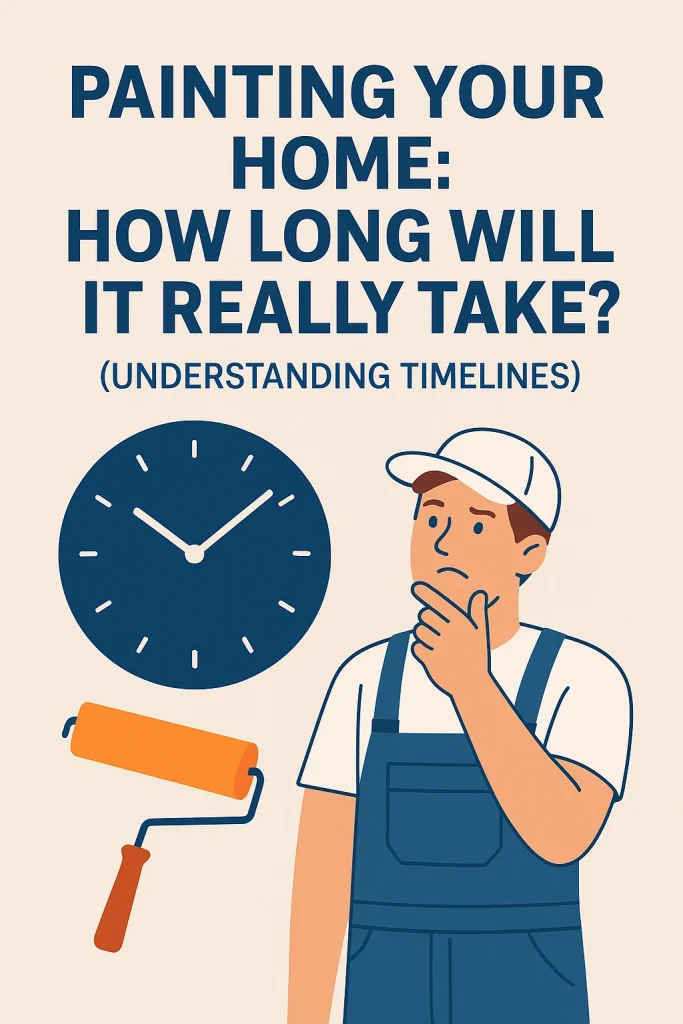It’s a question almost every homeowner asks when they start thinking about refreshing their space: “How long is this going to take?” Whether you’re planning a small update or a full home transformation, understanding the timeline is crucial for scheduling, budgeting, and managing expectations.
However, there’s no one-size-fits-all answer to how long it takes to paint a house or even a single room. The duration depends on a variety of factors. Let’s break it down.

Typical Timelines (Estimates)
While exact times vary wildly, here are some general estimates for how long painting might take, assuming standard conditions and a professional crew (DIY will generally take longer):
- A Single Room (Average Size): For walls and trim, a standard bedroom or living room typically takes 1 to 2 days. This includes setting up, preparation (patching, sanding, taping), painting two coats with drying time in between, and cleanup. Complex rooms with lots of trim or repair work could take longer.
- Painting Just Trim or Doors: If you’re only tackling trim and doors in a room or throughout a house, this can take 1-3 days depending on the amount and complexity (e.g., ornate mouldings vs. simple baseboards).
- Painting Just Ceilings: Painting just the ceilings in a few rooms might take half a day to a full day, again depending on size and condition.
- Full Interior (Average 3-4 Bedroom House): Painting the walls, ceilings, and trim throughout an average-sized home typically requires 3 to 7 days. This timeframe can stretch significantly for larger homes, homes with extensive damage, or intricate architectural details.
- Exterior (Average House): Exterior painting is highly variable. Factors like weather, size, and complexity play huge roles. An average-sized home exterior could take anywhere from 3 to 7 days, but larger or more complex properties (multi-story, lots of windows, extensive prep needed) can easily take 10 days or even longer.
Important Note: These are estimates. Your specific project’s timeline will depend heavily on the details.
Factors That Significantly Influence Painting Duration
So, what makes one painting job faster or slower than another? Here are the key factors:
- Size of the Area: This is the most obvious factor. More square footage or more rooms equals more time.
- Condition of the Surfaces: Is the current paint peeling, cracking, or bubbling? Are there many holes or dents in the walls? Is there mould or water damage? Extensive surface preparation (scraping, sanding, patching, cleaning, priming) is time-consuming but crucial and can easily double the project duration.
- Complexity of the Job:
- Architectural Details: Homes with a lot of intricate trim, crown moulding, wainscoting, or decorative features take much longer to tape, cut in, and paint carefully.
- High Ceilings or Difficult Access: Requires more time for setting up scaffolding or using ladders safely.
- Number of Colours: Painting each room a different colour or using accent walls adds time for switching paints and cutting in.
- Amount of Furniture/Belongings: Having to move and cover many items adds significant preparation time.
- Number of Coats Required: Changing from a dark colour to a light one (or vice-versa) almost always requires multiple coats (often 2-3) for proper coverage, adding substantial time, including necessary drying time between coats.
- Type of Paint and Surface: Some paints require specific application methods or longer drying times. Different surfaces (e.g., bare drywall, plaster, wood, metal, textured walls) require different preparation and painting techniques.
- Weather Conditions (Exterior Painting): Rain, high humidity, extreme heat, or cold can halt or significantly slow down exterior work, as paint needs specific conditions to dry and cure properly.
- Crew Size & Experience (If Hiring): A larger, more experienced crew can complete a job much faster than a single painter or a less experienced team.
- DIY vs. Professional: If you’re doing it yourself, especially for the first time, expect it to take significantly longer than a professional crew due to experience, technique, and equipment efficiency.
Don’t Underestimate Preparation Time!
This is worth repeating: Proper preparation is paramount and often takes up a significant portion of the total project time – sometimes as much as 50% or more! This includes cleaning, sanding, scraping, patching holes and cracks, taping edges, and priming. Skipping or rushing preparation to save time will invariably lead to a less durable, less attractive finish that won’t last.
Why Rushing Isn’t the Answer
While you might want your painting project finished as quickly as possible, trying to rush the process usually compromises quality. Applying coats before the previous one is dry, skipping prep steps, or not allowing adequate curing time can lead to issues like peeling, bubbling, poor coverage, and a generally unprofessional look. A good paint job requires patience and adherence to proper steps.
Getting an Accurate Timeline
The best way to get a realistic idea of how long your specific painting project will take is to:
- Assess Your Project: Consider the size, complexity, and condition of the area(s) you want to paint.
- Consult a Professional: If you’re hiring, get a detailed, written quote from reputable painters. They will evaluate the specific scope of work and provide a much more accurate timeline based on their experience and crew size.
Understanding the factors involved will help you appreciate the time required and plan your project effectively, ensuring a beautiful and long-lasting finish for your home.
